Items filtered by date: December 2024
Pickleball and Rheumatoid Arthritis
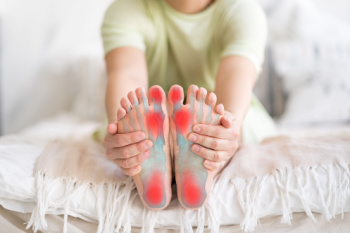
Pickleball, the fastest-growing sport in the United States, offers an excellent way for individuals with rheumatoid arthritis, or RA, to stay active while managing their condition. Unlike tennis or badminton, pickleball’s smaller court and slower pace make it easier on the joints, while still providing a fun, competitive workout. Regular movement is essential for people with RA, as it helps maintain joint flexibility, reduce stiffness, and improve overall mobility. Pairing pickleball with a nutrient-rich, anti-inflammatory diet supports joint health and boosts energy levels, enhancing your ability to play. Proper preparation, including warming up and wearing supportive footwear, is important to avoid strain on affected joints. If you are a pickleball player with rheumatoid arthritis, and if foot pain or joint discomfort becomes an issue, it is suggested that you schedule an appointment with a podiatrist for personalized care.
Because RA affects more than just your joints, including the joints in your feet and ankles, it is important to seek early diagnosis from your podiatrist if you feel like the pain in your feet might be caused by RA. For more information, contact Ross Limon, DPM of Boca Deerfield Footcare Center. Our doctor will assist you with all of your podiatric concerns.
What Is Rheumatoid Arthritis?
Rheumatoid Arthritis (RA) is an autoimmune disorder in which the body’s own immune system attacks the membranes surrounding the joints. Inflammation of the lining and eventually the destruction of the joint’s cartilage and bone occur, causing severe pain and immobility.
Rheumatoid Arthritis of the Feet
Although RA usually attacks multiple bones and joints throughout the entire body, almost 90 percent of cases result in pain in the foot or ankle area.
Symptoms
- Swelling and pain in the feet
- Stiffness in the feet
- Pain on the ball or sole of feet
- Joint shift and deformation
Diagnosis
Quick diagnosis of RA in the feet is important so that the podiatrist can treat the area effectively. Your doctor will ask you about your medical history, occupation, and lifestyle to determine the origin of the condition. Rheumatoid Factor tests help to determine if someone is affected by the disease.
If you have any questions, please feel free to contact our office located in Deerfield Beach, FL . We offer the newest diagnostic and treatment technologies for all your foot care needs.
All About High Heels in Winter
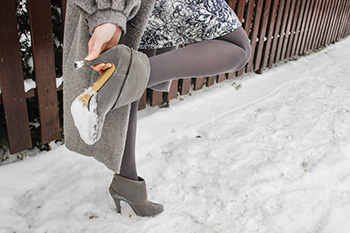
Wearing high heels during the winter can present unique challenges for the feet, toes, and ankles. The combination of slippery surfaces, icy sidewalks, and cold weather increases the risk of falls, frostbite, and strain on the lower extremities. Wearing high heels in winter often lead to instability, especially on ice-covered surfaces, which can cause sprains or fractures in the ankles. Also, the pressure on the forefoot from wearing high heels may increase discomfort, particularly when paired with reduced traction or improper footwear. Choosing footwear with features like closed toes, slip-resistant soles, and sturdy heel designs, such as block or wedge heels, can minimize these risks. Opting for styles with ankle support can further enhance stability while keeping feet warm and protected from snow and cold. A podiatrist can recommend proper winter footwear or address any pain caused by high heels. If you sustain a foot or ankle injury from wearing high heels, it is suggested that you schedule an appointment with a podiatrist for guidance.
High heels have a history of causing foot and ankle problems. If you have any concerns about your feet or ankles, contact Ross Limon, DPM from Boca Deerfield Footcare Center. Our doctor can provide the care you need to keep you pain-free and on your feet.
Effects of High Heels on the Feet
High heels are popular shoes among women because of their many styles and societal appeal. Despite this, high heels can still cause many health problems if worn too frequently.
Which Parts of My Body Will Be Affected by High Heels?
- Ankle Joints
- Achilles Tendon – May shorten and stiffen with prolonged wear
- Balls of the Feet
- Knees – Heels cause the knees to bend constantly, creating stress on them
- Back – They decrease the spine’s ability to absorb shock, which may lead to back pain. The vertebrae of the lower back may compress.
What Kinds of Foot Problems Can Develop from Wearing High Heels?
- Corns
- Calluses
- Hammertoe
- Bunions
- Morton’s Neuroma
- Plantar Fasciitis
How Can I Still Wear High Heels and Maintain Foot Health?
If you want to wear high heeled shoes, make sure that you are not wearing them every day, as this will help prevent long term physical problems. Try wearing thicker heels as opposed to stilettos to distribute weight more evenly across the feet. Always make sure you are wearing the proper shoes for the right occasion, such as sneakers for exercising. If you walk to work, try carrying your heels with you and changing into them once you arrive at work. Adding inserts to your heels can help cushion your feet and absorb shock. Full foot inserts or metatarsal pads are available.
If you have any questions, please feel free to contact our office located in Deerfield Beach, FL . We offer the newest diagnostic and treatment technologies for all your foot care needs.
The Importance of Tending to Ankle Pain
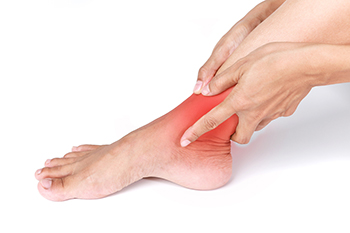
Ankle pain, often caused by injury, instability, or arthritis, can significantly increase the risk of developing osteoarthritis in the knee. When the ankle joint is compromised, it disrupts the natural biomechanics of walking leading to altered gait patterns. This imbalance shifts excessive stress to the knee joint as it compensates for the weakened ankle, accelerating cartilage wear and tear. Over time, the increased joint load contributes to inflammation, pain, and the progressive breakdown of knee cartilage, a hallmark of osteoarthritis. Addressing ankle pain early is essential to prevent this chain reaction. Podiatric treatments such as strengthening exercises, orthotics, or bracing can restore ankle stability and proper alignment. If you have ankle pain, it is suggested that you visit a podiatrist to have an exam and obtain treatment to prevent long-term complications, such as knee arthritis.
Ankle pain can be caused by a number of problems and may be potentially serious. If you have ankle pain, consult with Ross Limon, DPM from Boca Deerfield Footcare Center. Our doctor will assess your condition and provide you with quality foot and ankle treatment.
Ankle pain is any condition that causes pain in the ankle. Due to the fact that the ankle consists of tendons, muscles, bones, and ligaments, ankle pain can come from a number of different conditions.
Causes
The most common causes of ankle pain include:
- Types of arthritis (rheumatoid, osteoarthritis, and gout)
- Ankle sprains
- Broken ankles
- Achilles tendonitis
- Achilles tendon rupture
- Stress fractures
- Bursitis
- Tarsal tunnel syndrome
- Plantar fasciitis
Symptoms
Symptoms of ankle injury vary based upon the condition. Pain may include general pain and discomfort, swelling, aching, redness, bruising, burning or stabbing sensations, and/or loss of sensation.
Diagnosis
Due to the wide variety of potential causes of ankle pain, podiatrists will utilize a number of different methods to properly diagnose ankle pain. This can include asking for personal and family medical histories and of any recent injuries. Further diagnosis may include sensation tests, a physical examination, and potentially x-rays or other imaging tests.
Treatment
Just as the range of causes varies widely, so do treatments. Some more common treatments are rest, ice packs, keeping pressure off the foot, orthotics and braces, medication for inflammation and pain, and surgery.
If you have any questions please feel free to contact our office located in Deerfield Beach, FL . We offer the newest diagnostic tools and technology to treat your foot and ankle needs.
Identifying Charcot-Marie-Tooth Disease
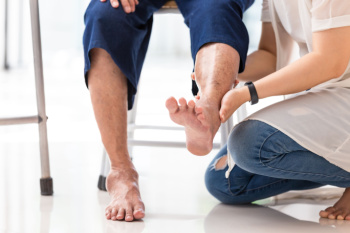
Charcot-Marie-Tooth disease, or CMT, is a genetic condition that primarily impacts the peripheral nerves, which connect the brain and spinal cord to the rest of the body. This condition often begins to affect the feet and lower legs first, with symptoms typically starting between the ages of 5 and 15. People with Charcot-Marie-Tooth disease may experience high-arched feet, flat feet, hammertoes, muscle weakness in the lower legs, foot drop, and a distinctive high-stepping gait to avoid tripping. Over time, these issues can lead to muscle wasting in the legs, which creates challenges with walking and balance. A podiatrist plays a key role in managing the symptoms of this incurable condition by providing specialized care for foot deformities and gait issues. This may include custom orthotics to support the feet, recommendations for proper footwear, or bracing to improve stability and mobility. Such interventions can enhance a person’s quality of life and reduce discomfort associated with CMT. If you believe you have symptoms of Charcot-Marie-Tooth disease, it is suggested that you schedule an appointment with a podiatrist to help manage this condition.
Neuropathy
Neuropathy can be a potentially serious condition, especially if it is left undiagnosed. If you have any concerns that you may be experiencing nerve loss in your feet, consult with Ross Limon, DPM from Boca Deerfield Footcare Center. Our doctor will assess your condition and provide you with quality foot and ankle treatment for neuropathy.
What Is Neuropathy?
Neuropathy is a condition that leads to damage to the nerves in the body. Peripheral neuropathy, or neuropathy that affects your peripheral nervous system, usually occurs in the feet. Neuropathy can be triggered by a number of different causes. Such causes include diabetes, infections, cancers, disorders, and toxic substances.
Symptoms of Neuropathy Include:
- Numbness
- Sensation loss
- Prickling and tingling sensations
- Throbbing, freezing, burning pains
- Muscle weakness
Those with diabetes are at serious risk due to being unable to feel an ulcer on their feet. Diabetics usually also suffer from poor blood circulation. This can lead to the wound not healing, infections occurring, and the limb may have to be amputated.
Treatment
To treat neuropathy in the foot, podiatrists will first diagnose the cause of the neuropathy. Figuring out the underlying cause of the neuropathy will allow the podiatrist to prescribe the best treatment, whether it be caused by diabetes, toxic substance exposure, infection, etc. If the nerve has not died, then it’s possible that sensation may be able to return to the foot.
Pain medication may be issued for pain. Electrical nerve stimulation can be used to stimulate nerves. If the neuropathy is caused from pressure on the nerves, then surgery may be necessary.
If you have any questions, please feel free to contact our office located in Deerfield Beach, FL . We offer the newest diagnostic and treatment technologies for all your foot care needs.
It's Time for Beautiful Feet
Conquering Athlete’s Foot
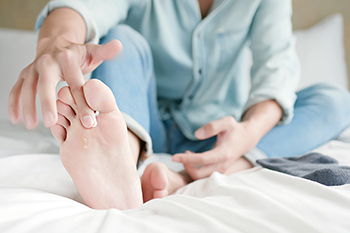
Athlete’s foot is a fungal infection that impacts most people at some time during their lives. Athlete's foot is caused by dermatophytes, fungi that invade the skin and thrive in damp or sweaty environments. It typically appears between the toes where the fungus irritates the skin, causing it to crack, and peel. Symptoms include redness, itching, stinging, and a burning sensation, sometimes accompanied by an unpleasant odor. It is important to keep the feet clean and dry to prevent athlete’s foot. However, if you develop this infection, it is suggested that you contact a podiatrist for a proper diagnosis and treatment.
Athlete’s foot is an inconvenient condition that can be easily reduced with the proper treatment. If you have any concerns about your feet and ankles, contact Ross Limon, DPM from Boca Deerfield Footcare Center. Our doctor will treat your foot and ankle needs.
Athlete’s Foot: The Sole Story
Athlete's foot, also known as tinea pedis, can be an extremely contagious foot infection. It is commonly contracted in public changing areas and bathrooms, dormitory style living quarters, around locker rooms and public swimming pools, or anywhere your feet often come into contact with other people.
Solutions to Combat Athlete’s Foot
- Hydrate your feet by using lotion
- Exfoliate
- Buff off nails
- Use of anti-fungal products
- Examine your feet and visit your doctor if any suspicious blisters or cuts develop
Athlete’s foot can cause many irritating symptoms such as dry and flaking skin, itching, and redness. Some more severe symptoms can include bleeding and cracked skin, intense itching and burning, and even pain when walking. In the worst cases, Athlete’s foot can cause blistering as well. Speak to your podiatrist for a better understanding of the different causes of Athlete’s foot, as well as help in determining which treatment options are best for you.
If you have any questions please feel free to contact our office located in Deerfield Beach, FL . We offer the newest diagnostic and treatment technologies for all your foot and ankle needs.




